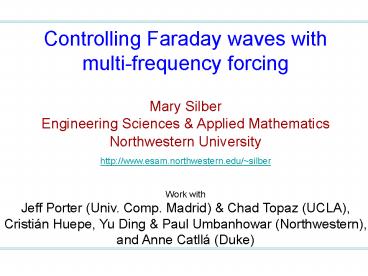Controlling Faraday waves with multifrequency forcing - PowerPoint PPT Presentation
1 / 37
Title: Controlling Faraday waves with multifrequency forcing
1
Controlling Faraday waves with multi-frequency
forcing
Mary SilberEngineering Sciences Applied
Mathematics Northwestern University http//www.es
am.northwestern.edu/silber Work with Jeff
Porter (Univ. Comp. Madrid) Chad Topaz (UCLA),
Cristián Huepe, Yu Ding Paul Umbanhowar
(Northwestern), and Anne Catllá (Duke)
2
FARADAY CRISPATIONS
M. Faraday, Phil. Trans. R. Soc. Lond. (1831)
3
FARADAY CRISPATIONS
M. Faraday, Phil. Trans. R. Soc. Lond. (1831)
4
Edwards and Fauve, JFM (1994)
12-fold quasipattern
Bordeaux to Geneva 5cm, depth 3mm
5
Kudrolli, Pier and Gollub, Physica D (1998)
Superlattice pattern
Birfurcation theoretic investigations of
superlattice patterns Dionne and Golubitsky,
ZAMP (1992) Dionne, Silber and Skeldon,
Nonlinearity (1997) Silber and Proctor, PRL (1998)
6
Arbell Fineberg, PRE 2002
7
FARADAY CRISPATIONS
8
LINEAR STABILITY ANALYSIS
Benjamin and Ursell, Proc. Roy. Soc. Lond. A
(1954)
Considered inviscid potential flow
in modulated gravity
with free surface given by
Find satisfy the Mathieu equation
gravity-capillary wave dispersion relation
with
9
MATHIEU EQUATION
Subharmonic resonance
From Jordan Smith
10
- Huge, easily accessible control parameter space
- Multiple length scales compete (or cooperate)
(Naïve) Schematic of Neutral Stability Curve
overall forcing strength
m/2
n/2
p/2
q/2
wave number k
cf. Huepe, Ding, Umbanhowar, Silber (2005)
11
- Huge, easily accessible control parameter space
- Multiple length scales compete (or cooperate)
Goal Determine how forcing function parameters
enhance (or inhibit) weakly nonlinear wave
interactions. Benefits Helps interpret existing
experimental results. Leads to design strategy
how to choose a forcing function that favors
particular patterns in lab experiments.
Approach equivariant bifurcation theory.
Exploit spatio-temporal symmetries (and remnants
of Hamiltonian structure) present in the
weak-damping/weak-driving limit. Focus on
(weakly nonlinear) three-wave interactions as
building blocks of spatially-extended patterns.
12
- Lowest order nonlinear interactions
- Building blocks of more complex patterns
k1 k2 k3
k2
k3
qres
k1
Resonant triads Faraday waves Müller, Edwards
Fauve, Zhang Viñals,
13
- Role in pattern selection a simple example
k2
k3
critical modes
damped mode
qres
k1
spatial translation, reflection, rotation by p
14
- Role in pattern selection a simple example
k2
k3
critical modes
damped mode (eliminate)
qres
k1
center manifold reduction
15
- Role in pattern selection a simple example
k2
suppressing, competitive
enhancing, cooperative
qres
k1
rhombic equations
16
(No Transcript)
17
consider free energy
nonlinear coupling coefficient
18
forcing
Expanded TW eqns.
Hamiltonian structure
SW eqns.
time translation, time reversal symmetries
damping
Porter Silber, PRL (2002) Physica D (2004)
19
- Parameter (broken temporal) symmetries
um denotes dominant driving frequency
time translation symmetry
20
- Parameter (broken temporal) symmetries
time reversal symmetry
Hamiltonian structure (for )
(See, e.g., Miles, JFM (1984))
21
- Enforce symmetries ? Travelling wave amplitude
equations
damping
parametric forcing
damping
22
- Enforce symmetries ? Travelling wave amplitude
equations
Example (m,n) forcing, ?m-n
23
- Enforce symmetries ? Travelling wave amplitude
equations
Porter, Topaz and Silber, PRL PRE 2004
24
- Strongest interaction is for W m
- Parametrically forcing damped mode can strengthen
interaction - Phases fu may tune interaction strength
- Only W n m is always enhancing (Hamiltonian
argument)
ex. (m,n, p 2n 2m) forcing, W n mgt0
gt 0
Pp(F) gt 0
bres gt 0 for this case(can get signs for some
other cases)
25
Zhang Viñals, J. Fluid Mech 1997
26
k2
q
k1
Solvability condition at
27
- Strongest interaction is for W m
- Parametrically forcing damped mode can strengthen
interaction - Phases fu may tune interaction strength
- Only W n m is always enhancing (bres gt 0)
ex. (6,7,2) forcing, b(?)computed from
Zhang-Viñals equations
W n m 1
W m 6
28
Kudrolli, Pier and Gollub, Physica D (1998)
Topaz Silber, Physica D (2002)
29
Epstein and Fineberg, 2005 preprint.
6/7/2 forcing frequencies
32
53
30
Epstein and Fineberg, 2005 preprint.
32
43
53
31
Arbell Fineberg, PRE, 2002
(3,2,4)forcing
(3,2)forcing
32
(See J. Bechhoefer B. Johnson, Am. J. Phys.
1996)
33
(Catllá, Porter and Silber, PRE, in press)
One-dim. waves Weakly nonlinear analysis from Z-V
equations.
C
sinusoidal
Capillarity parameter
Prediction based on 2-term truncated Fourier
series
34
Huepe, Ding, Umbanhowar, Silber, 2005 preprint
Forcing function Neutral Curve
35
Linear analysis, aimed at finding envelope of
neutral curves ( following Cerda Tirapegui,
JFM 1998) Lubrication approximation shallow,
viscous layer, low-frequency forcing Transform
to time-independent Schrödinger eqn.,1-d periodic
potential
WKB approximation
Matching across regions gives transition
matrices Periodicity requirement determines
stability boundary
36
Exact numerical
WKB approximation
37
- Determined how which parameters in periodic
forcing function influence weakly nonlinear
3-wave interactions. - Weak-damping/weak-forcing limit leads to scaling
laws and phase dependence of coefficients in
bifurcation equations. - Hamiltonian structure can force certain
interactions to be cooperative, while others
are competitive. - Results suggest how to control pattern selection
by choice of forcing function frequency content.
( cf. experiments by Finebergs group). - Symmetry-based approach yields model-independent
results arbitrary number of (commensurate)
frequency components. (even infinite -- impulsive
forcing) - Shallow, viscous layers present new challenges































